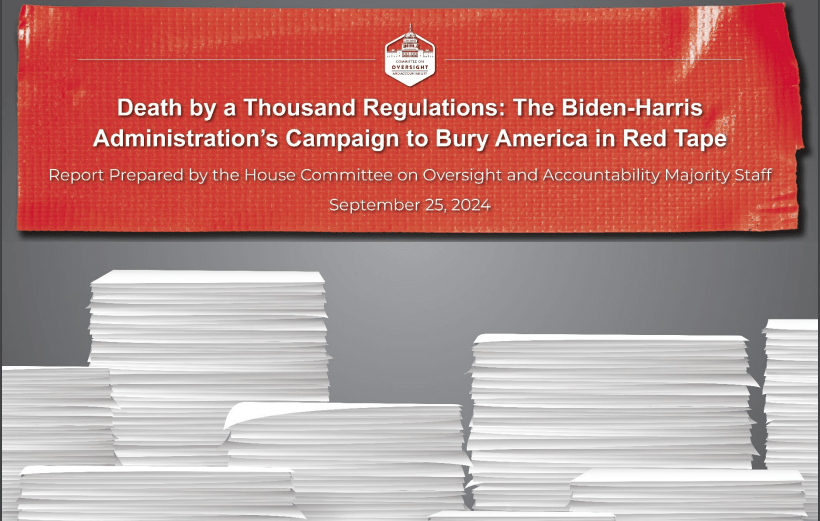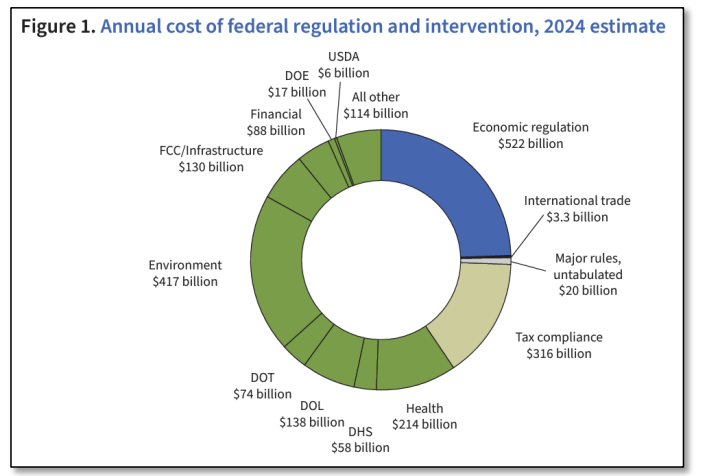The House Committee on Oversight estimates Biden-Harris regulations will cost consumers and businesses a whopping $1.5 trillion dollars

Death by 1,000 Regulations
Please consider The Biden-Harris Campaign to Bury America in Red Tape
The report is 26 pages. Here are some highlights.
The Biden-Harris Administration’s cumulative new regulatory costs imposed to date surpass those of all predecessors. As of August 30, 2024, the Biden-Harris Administration has imposed an estimated $1.7 trillion dollars in regulatory costs on the U.S. economy. This includes only the costs of new rules for which the Administration has prepared cost estimates, meaning the regulatory burden added by the Administration to date may be substantially higher. According to a report released this year by the Competitive Enterprise Institute, “[i]f it were a country, US regulation would be the world’s 10th-largest economy, ranking behind Canada and ahead of Italy.” For American households, this acts as a regulatory “hidden tax” of $15,788 on average—a household burden exceeded only by housing costs.
As a prominent example, the advertised benefits of many climate-focused regulations— often heralded as providing greater environmental outcomes via carbon or other greenhouse-gas reductions—come at the expense of lower income individuals who have less disposable income to adapt to changing price structures. Under the Biden-Harris EPA’s Multi-Pollutant Emissions Standards for Model Years 2027 and Later Light-Duty and Medium-Duty Vehicles, EPA estimates suggest that the price of light trucks and SUVs alone are estimated to increase by over $8,000 by 2032. Meanwhile, automakers across the country are faced with the significant challenge of balancing low consumer demand for electric vehicles with regulatory compliance
The Biden-Harris Department of Labor (DOL) has used its rule-making authority to overregulate private-sector workplaces. For example, many business entities use the classification of “independent contractors” instead of “employees” depending on their business structure. But, the Biden-Harris DOL has intervened with a rule restricting choice and forcing companies to list people or entities as “employees” rather than “contractors.” This change is expected to increase costs dramatically in many sectors of the economy, including trucking, manufacturing, health care, and “gig” services (e.g., app-based services) and other innovative new forms of jobs. In addition, Biden-Harris immigration policies continue to have a detrimental effect on the labor force. For example, the Administration allows expedited work authorizations for illegal aliens who file asylum claims, the volume of which leads to “a never-ending task” for the U.S. Citizenship and Immigration Services.
In stark contrast to the Biden-Harris Administration, the Trump Administration achieved a net reduction in regulatory costs of nearly $200 billion by pursuing reforms to restrain regulatory overreach while achieving Congress’ regulatory goals. For example, on January 30, 2017, President Trump issued Executive Order 13771, “Reducing Regulation and Controlling Regulatory Costs.” This order ensured that agencies “be prudent and financially responsible in the expenditure of funds,” and imposed an annual regulatory cost cap, and required the elimination of two regulations for every new regulation issued in order to meet the cap.61 This was followed by Executive Order 13777, “Enforcing the Regulatory Reform Agenda,” and later Executive Order 13893, “Increasing Government Accountability for Administrative Actions by Reinvigorating Administrative PAYGO,” and other orders.
The Biden-Harris Administration’s regulatory blowout has contributed to a struggling, inflationary economy, hurting businesses and consumers. The Administration has continued to push forward with its aggressive regulatory overreach even in the wake of the Supreme Court’s decision in West Virginia v. EPA, 597 U.S. 697 (2022).
Conclusion
The scope and scale of new federal regulation under the Biden-Harris Administration has been nothing short of record-breaking. With over $1.7 trillion in regulatory costs instituted in less than four years, the Biden-Harris Administration has imposed burdens far surpassing those of previous administrations. These actions, if not rescinded or overturned by the courts, threaten long-lasting, adverse economic consequences. The Biden-Harris Administration has disregarded even rebukes from the Supreme Court to implement these transformative changes across entire sectors of the economy.
Cost of Federal Regulation

I found it difficult to condense 26 pages into something readable. The biggest chunks of over-regulation were in green energy, economic regulations, and tax compliance.
September 26: Trump Claims Tariffs Will Reduce the Trade Deficit. Let’s Fact Check.
Trump proposes 60 percent tariffs on China. Would that reduce the trade deficit? Where? How?
October 1: Trump vs Frederic Bastiat: Who Is Right About Tariffs?
Previously, I discussed tariffs and the trade deficit. This post is about Trump’s proposal to use tariffs to fund projects.
October 2: Trump and Biden Pander to Absurd Demands of Striking Dockworkers
The Atlantic and Gulf strike halts about 50% of US container trade. This is serious.
October 3: Small Businesses Reducing Workers for the Last Five Months
ADP data shows small businesses with 1-49 workers have been reducing workers for five months.
